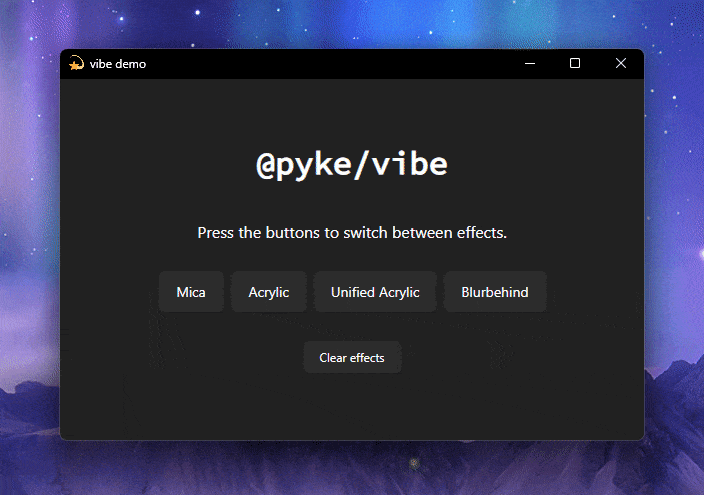vibe is a library for acrylic/vibrancy effects for Electron on Windows 10/11. Any Electron version compatible with N-API v6 (Electron v11+) is supported.
Native support for Windows background materials recently landed in Electron: electron/electron#38163
vibe will continue to be maintained until Electron v25+ becomes mainstream.
A recent version of Rust (>=1.56.1) is required. You can install it via rustup.
If you don't plan on doing Rust development, you may choose to install the minimal profile in rustup to install a lighter Rust toolchain.
For end users, the Acrylic effect is supported in Windows 10 builds later than build 17763, and the Mica effect is supported in Windows 11 only. vibe uses an undocumented API for enabling Mica on early builds of Windows 11 (specifically pre-22H2, build <22523) that is not heavily tested and may not work at all.
Note: If you'd like to use
vibewith Discord on Windows, you'll need to install an additional Rust target:rustup target add i686-pc-windows-msvc, then buildvibewithnpm run build:windows-i686. You can then use the resultingindex.nodefile like you'd use@pyke/vibe.
There are 3 important points you must keep in mind when using vibe:
vibemust do some trickery on the Electronappobject before Electron loads in order for effects to work, so don't forget to runvibe.setup(app)beforeapp.whenReady().- Keep the default frame. Windows gets fussy about frames when you attempt to use acrylic effects.
titleBarStylemust always be set todefaultandframemust always be set totrue. While there is a way to have titlebar-less framed Mica windows, it does not work with Electron, and would unfortunately require changes in Electron's internals. - Both
htmlandbodyneed to be transparent in CSS. It's a common mistake to only make eitherhtmlorbodyhavebackground: transparent, but both of them need to be transparent. Additionally, you must set the Electron window'sbackgroundColorto#00000000to trick Electron into making a framed transparent window. Do not settransparenttotrue, as this will disable the frame and effects will break.
const { app, BrowserWindow, nativeTheme } = require('electron');
const vibe = require('@pyke/vibe');
// Very important - let vibe perform its magic before the app is ready
vibe.setup(app);
app.whenReady().then(() => {
const mainWindow = new BrowserWindow({
...,
// This part is very important!
backgroundColor: '#00000000',
// Recommendation: Wait to show the window to avoid an ugly flash of non-acrylic-ized content.
show: false,
// Recommendation: Hide the menu bar, as the colour of the bar will be solid and will look janky.
autoHideMenuBar: true
});
// Apply effects! 💫
// This should be run before the window is ready to be shown.
vibe.applyEffect(mainWindow, 'acrylic');
// To disable effects, run `clearEffects`.
// The background colour of the window will be black, so you should reset the window's background colour here and/or send a message to the renderer to update the CSS.
vibe.clearEffects(mainWindow);
mainWindow.setBackgroundColor('#ffffff');
});The acrylic effect for Windows 10 and below can also have a 'tint' applied to it:
vibe.applyEffect(mainWindow, 'acrylic', '#AA80FF40');NOTE: The Windows 11 22H2 'Fluent' Acrylic & Mica effects cannot be tinted and will simply follow the window/system theme (see below). You can use vibe.platform.isWin11_22H2() to detect if the system is Windows 11 22H2 or greater and style your app appropriately.
const supportsFluentAcrylic = vibe.platform.isWin11_22H2(); // Win 11 before 22H2 does not support Fluent Acrylic
const supportsMica = vibe.platform.isWin11();
const supportsTintableAcrylic = !vibe.platform.isWin11();Additionally, you can use Electron's nativeTheme module to force the theme of the acrylic effects:
const { nativeTheme } = require('electron');
nativeTheme.themeSource = 'dark';or, for older versions of Electron:
vibe.forceTheme(mainWindow, 'dark');
vibe.forceTheme(mainWindow, 'light');Need help? Visit the #📕|vibe channel in the pyke Discord server:
- Enabling the "Show accent color on title bars and windows borders" setting in Personalization > Colors on Windows styles the titlebar as a solid colour when using the Mica & Acrylic effects.
- Workaround: No workaround, but disabling the setting fixes it.
blurbehinddoes not work on Windows 11 and later Windows 10 builds.- Workaround: Use
acrylicorunified-acrylicon these platforms instead.
- Workaround: Use
unified-acryliclags when moving the window on Windows 11 and later Windows 10 builds.- Workaround: None, this is a long standing issue with Windows that will likely never be fixed. Use the fluent
acryliceffect instead;
- Workaround: None, this is a long standing issue with Windows that will likely never be fixed. Use the fluent
- Tauri's
window-vibrancypackage, which vibe borrows some code from. - @alexmercerind for discovering the
DwmExtendFrameIntoClientAreahack - @sylveon for finding a workaround to
transparent: true - @GregVido for discovering the
enable-transparent-visualshack - Twitter for providing the
vibe'icon' used in the demo 💫
